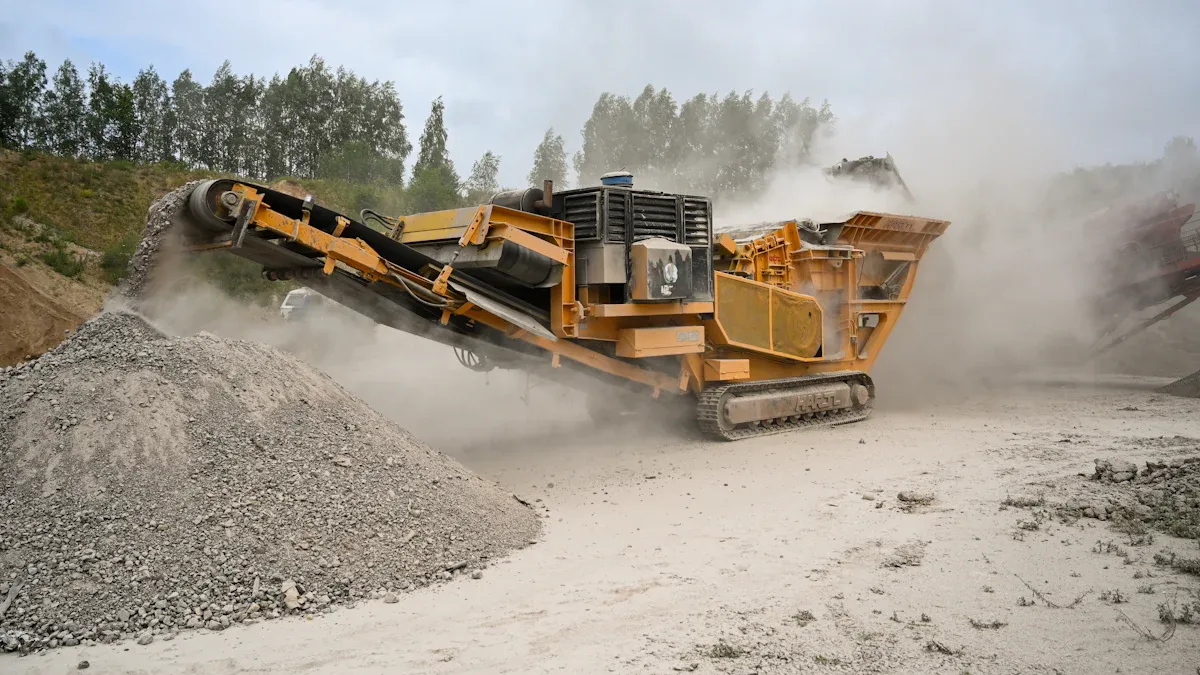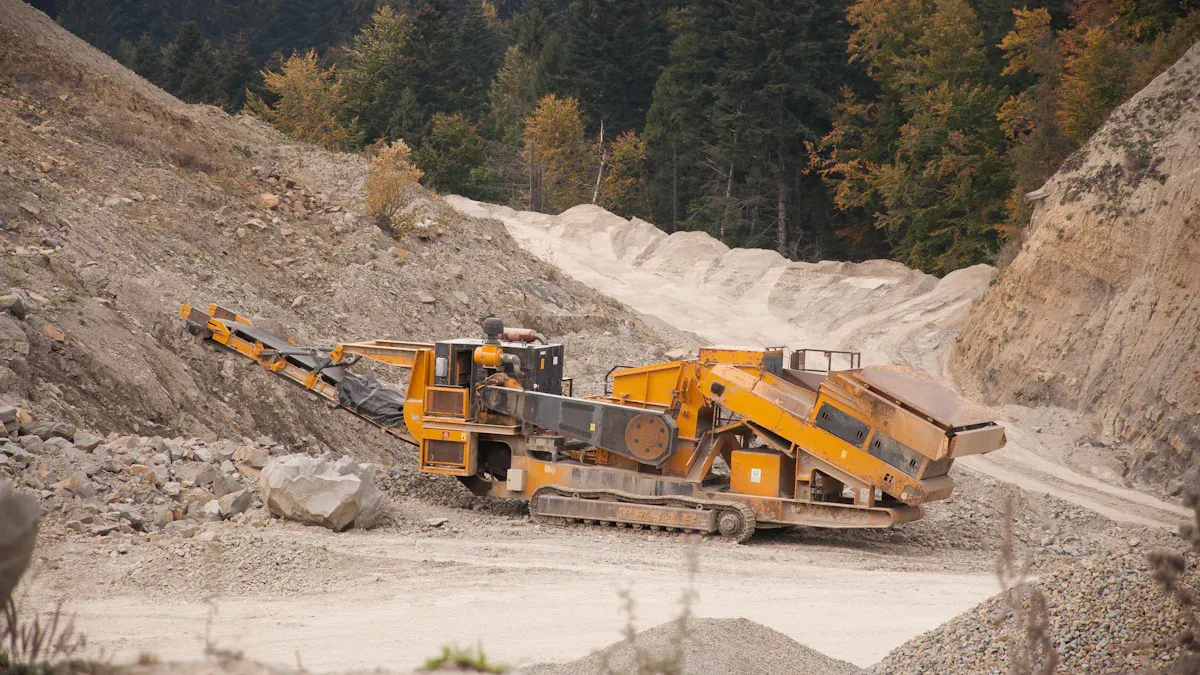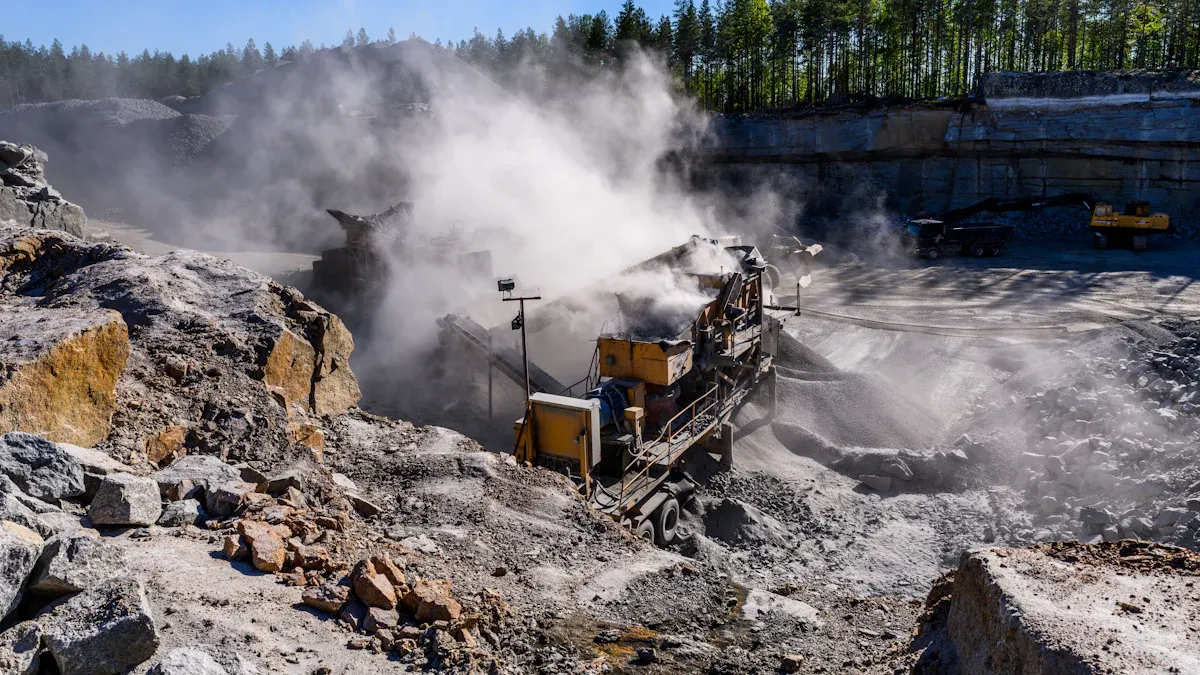
Optimizing your jaw crusher hopper plays a vital role in improving your equipment's efficiency and lifespan. A well-designed hopper ensures smooth material flow, reducing blockages and wear. This not only enhances performance but also minimizes downtime, saving you time and money. Regular maintenance and proper care further boost durability, keeping your crusher running at its best. By taking these steps, you can maximize productivity and ensure reliable operation for years to come.

Choosing the right hopper size is crucial for optimizing your jaw crusher hopper. A hopper that is too small can lead to frequent overloading, causing unnecessary wear and tear on your equipment. On the other hand, an oversized hopper may result in inefficient material handling and wasted space. You should assess your production needs and the volume of material processed daily. This ensures the hopper size aligns with your operational requirements.
A properly sized hopper also improves safety. It minimizes the risk of spillage and reduces the need for manual intervention, which can lead to accidents. By selecting the appropriate size, you create a more efficient and safer working environment.
The shape of your hopper plays a significant role in ensuring smooth material flow. Poorly designed hoppers can cause material blockages, leading to downtime and reduced productivity. To avoid these issues, consider using optimized shapes like conical or wedge-shaped hoppers.
| Hopper Shape | Key Design Feature | Flow Issue Prevented |
|---|---|---|
| Circular Outlet | Large enough to prevent stable rathole development | Cohesive arching |
| Wedge-shaped Hopper | Outlet width must be sufficient to avoid cohesive arch formation | Cohesive arching |
| Conical Hopper | Steeper converging walls required for mass flow | Flow problems due to wall friction |
| Wedge-shaped Hopper | Sloping walls can be 10-12 degrees less steep than conical hoppers for mass flow | High wall friction materials |
For example, a conical hopper with steep walls promotes mass flow, reducing the chances of material sticking to the sides. Wedge-shaped hoppers, on the other hand, are ideal for materials with high wall friction. By selecting the right shape, you can prevent common flow issues like arching and ratholing, ensuring consistent material movement.
The materials used in your hopper's construction directly impact its performance and longevity. High-quality steel is an excellent choice due to its durability and resistance to wear. Steel hoppers are designed to withstand heavy loads and harsh industrial environments. They resist corrosion, rust, and weathering, making them suitable for long-term use.
Enhanced Safety: Reinforced steel construction reduces the risk of accidents and injuries.
Efficiency: Self-dumping mechanisms allow for quick and easy unloading of materials.
Versatility: Suitable for a variety of materials, including waste, scrap, and raw materials.
Durability: Steel construction ensures long-lasting performance even in harsh environments.
Additionally, using durable materials contributes to environmental sustainability. Steel hoppers promote efficient material handling and reduce waste. Their long lifespan minimizes the need for replacements, lowering the environmental impact associated with manufacturing and disposal. By investing in high-quality materials, you enhance the operational efficiency and durability of your jaw crusher hopper.

Overloading your jaw crusher hopper can lead to material blockages, causing unnecessary downtime and equipment wear. To prevent this, you should monitor the material input closely and ensure it matches the hopper's capacity. Avoid dumping excessive material at once, as this can create uneven flow and increase the risk of clogging.
Using proper loading techniques also helps maintain consistent flow. For example, evenly distributing material across the hopper prevents uneven wear and reduces the chances of blockages. You can train your operators to follow best practices for loading, ensuring smooth operation and reducing maintenance needs.
Tip: Always keep an eye on the hopper's load level. Installing sensors can help you detect overloading early and take corrective action before it affects performance.
Vibratory feeders and grizzly screens are excellent tools for ensuring consistent material flow. Vibratory feeders use centrifugal force to separate materials by size, promoting efficient classification during processing. This mechanism ensures a stea dy flow of materials into the crusher, reducing interruptions.
Vibratory feeders handle large quantities of mate rial efficiently.
They maintain a higher fl ow rate, allowing for faster processing.
Their simple design reduces installation and operational costs.
Grizzly screens, on the other hand, filter out oversized materials before they enter the hopper. This prevents blockages and ensures only the right-sized materials reach the crusher. By using these tools, you can improve the efficiency and reliability of your jaw crusher hopper.
Lower installation costs compared to more complex equipment.
Reduced power consumption, saving on operational expenses.
Fewer moving parts, leading to less maintenance and downtime.
Monitoring and adjusting feed rates is crucial for maintaining consistent material flow. Advanced feeding technologies, such as volumetric and gravimetric feeders, provide precise control over feed rates. These systems can handle bulk density changes and ensure consistent material density.
| Feeding Technology | Type of Feeder | Key Metrics Documented |
|---|---|---|
| Single-screw extr uders | Volumetric feeders | Consistent density handling |
| Twin-screw extruders | Gravimetric feeders | Precise operation, reacts to bulk density changes |
| LIW feeders | Advanced controllers | Real-time data collection, historical data storage |
You should regularly check the feed rate metrics to identify any inconsistencies. Adjusting the feed rate based on these metrics helps maintain a steady flow, preventing overloading and reducing wear on your equipment.
Note: Investing in advanced feeding systems can provide real-time data, helping you make informed decisions to optimize material flow.
Regular inspections are essential for keeping your jaw crusher hopper in optimal condition. By identifying wear and damage early, you can prevent unexpected failures that lead to costly downtime. Focus on checking critical areas such as the hopper walls, outlet, and liners. Look for signs of corrosion, cracks, or excessive wear.
Tip: Implementing dust control measures during inspections can reduce wear caused by abrasive particles. Modern hydraulic systems also simplify adjustments, minimizing maintenance-related downtime.
Create a checklist for inspections to ensure consistency. Include visual checks, measurements, and tests for structural integrity. This proactive approach helps you address issues before they escalate, ensuring uninterrupted operations.
Material build-up inside the hopper can disrupt operations and reduce efficiency. Cleaning the hopper regularly prevents these issues and ensures smooth material flow. Customiz ed liners, such as ISOSOCK™, make cleaning easier by preventing materials like sand from sticking to the hopper's interior. This innovation enhances safety by reducing the need for manual cleaning tools and minimizes downtime, boosting production efficiency.
Acoustic cleaning technology offers another effective solution. It uses sound waves to dislodge compacted materials, removing blockages and preventing future build-up. For sticky materials like gypsum, installing AIRCHOC® air cannons at strategic points can alleviate flow problems and maintain smooth operations.
Note: Regular cleaning not only improves efficiency but also extends the lifespan of your hopper by reducing wear caused by accumulated materials.
Delaying the replacement of worn or damaged components can lead to severe operational issues. Replace liners, bolts, and other parts as soon as you notice signs of wear. This prevents further damage to the hopper and ensures consistent p erformance.
Use high-quality replacement parts to ma intain durability. For example, steel components resist corrosion and withstand heavy loads, making them ideal for long-term use. Keep spare parts readily available to minimize downtime during replacements.
Tip: Schedule routine maintenance checks to identify components nearing the end of their lifespan. This proactive approach reduces the risk of unexpected failures and keeps your jaw crusher hopper running efficiently.
Optimizing your jaw crusher hopper through design, material flow, and maintenance delivers measurable benefits. A well-designed hopper reduces flow issues like arching and ratholing, ensuring reliable material movement. Facilities that adopted optimized hopper designs reported a 20% increase in sludge concentration and improved sedimentation efficiency. Consistent material flow, supported by tools like vibratory feeders, minimizes downtime and enhances throughput. Proactive maintenance extends equipment lifespan, with some facilities noting a 15% decrease in energy usage for sludge pumping after implementing regular upkeep routines.
These strategies improve operational efficiency, reduce downtime, and lower costs. Reliable flow is essential for bulk material handling, and advanced design principles help overcome common challenges. Take immediate steps to optimize your hopper and unlock these benefits for your operations.
High-quality steel works best for hopper construction. It resists wear, corrosion, and heavy loads. Steel ensures durability and long-term performance, even in harsh environments. Using durable materials reduces maintenance needs and extends the hopper's lifespan.
Inspect your hopper weekly or biweekly. Regular checks help you identify wear, cracks, or blockages early. This proactive approach prevents unexpected failures and minimizes downtime, keeping your operations running smoothly.
Yes, vibratory feeders ensure consistent material flow. They separate materials by size and maintain a steady feed rate. This reduces blockages and enhances crusher efficiency, making them a valuable addition to your setup.
Clean the hopper regularly to avoid material build-up. Use tools like acoustic cleaning systems or air cannons for sticky materials. These methods ensure smooth material flow and reduce wear caused by accumulated debris.
The hopper's shape affects how materials move. Conical or wedge-shaped hoppers promote smooth flow and prevent blockages like arching or ratholing. Choosing the right shape ensures consistent material movement and reduces downtime.